The first pyramid, which gave rise to all Egyptian pyramid construction, is located in Saqqara, about 17 km south of Giza. It was built in 2667-2648 BC for Djoser, the first pharaoh of the third dynasty.
The history of the construction of the pyramid of Djoser
The invention of masonry is attributed to the beginning of the reign of Djoser. The pyramid of Djoser is considered the oldest stone structure on Earth, its prototype was the mastabs of the pharaohs of the first dynasty, built of adobe bricks. At first it was also a stone mastaba, but then it went through five stages in its development.
First, the architect of the pharaoh Imhotep erected a large mastaba, similar to the previously built tomb of Djoser in Upper Egypt. This time, the mastaba was not made of bricks, but of stone blocks. Subsequently, during the reign of the pharaoh, it was expanded in four directions, and then made oblong. The decision to expand the building for the fourth time led to the fact that a tomb appeared, unlike any previously erected. Imhotep built three more mastabas, placing them one above the other, each of them was smaller than the previous one. This is how the first step pyramid appeared, which became the prototype of all the Egyptian pyramids.
However, Djoser wanted to make the pyramid even larger, he ordered to increase its base, to make six terraces at its top. The pyramid was faced with limestone, which was brought from the opposite bank of the Nile, from the hills of Tura.
Design features
To create the stepped pyramid of Djoser, several independent layers of masonry were used, they rested on a central crushed stone base. In a similar way, all the pyramids that appeared in the future were built - Khafre, Khufu and other pharaohs who reigned later. However, unlike the later pyramids, the stone blocks are tilted inward at an angle of 74 ° in order to give the structure more strength. In the pyramids built later, the layers of masonry are arranged horizontally.
Djoser's tomb was located under the foundation, it was carved into the rocky ground, a square shaft led to it. The entrance to the mine was located far beyond the pyramid, to the north of it. A massive ten-meter wall was built around the pyramid, and inside it was an area on which several temples and
One of the seven wonders of the world is the pyramids of ancient Egypt, which will be briefly discussed in this article. The age of these unique structures is about 4500 years. The most famous pyramids, which are especially popular with tourists and explorers, are located on the opposite bank of the Nile from the Egyptian capital - in the ancient cemetery in Giza. Scientists say that at that time more than a hundred pyramids were erected, but only a small part of them has survived to this day, which is currently an important landmark of Egypt. These mysterious structures there was a special purpose as the tombs of the pharaohs and their wives. The pyramids were built using masonry, some of them were faced.
The earliest construction is considered the tomb of King Djoser, built according to the design of the ancient Egyptian architect Imhotep. This pyramid has a peculiar, stepped shape.
The most famous is the pyramid of Cheops. Until the middle of the 19th century, this building was considered the largest in the whole world. Its height is 147 meters, all sides are completely symmetrical, and the building area is more than 50 thousand square meters. But for all its greatness, and despite the impressive size of the Cheops pyramid itself, its internal premises make up no more than 5 percent of the entire area. The name of the architect who designed such a monumental structure is also known - his name was Hemuin.
The second largest is the Khafre pyramid. In height, it is less than the Cheops pyramid by only a few meters, but it is located on a higher and steeper hill. At the same time, a statue of the Great Sphinx is located near the pyramid. Many Egyptologists believe (although this has not been proven) that the face of the Sphinx is a stone portrait of Khafre. In addition, this pyramid is distinguished from others by the fact that only two chambers were found in it, which rightfully allows it to be considered the most compact structure in the world. The free space in this tomb is less than one hundredth of a percent of the total. Some researchers in this case pay attention to the records of the ancient Greek historian Diodorus, who in his collections reports that Khafre was hated so much by his contemporaries that his real tomb had to be made not in a pyramid, but in a secret place.
Among the pyramids of Ancient Egypt there are those that differ from the classical idea of them. They are distinguished by their unusual shape. For example, the pyramid in Medum, built for the pharaoh Huni. Initially, this building had a stepped shape and consisted of seven steps, but today only three are visible. This happened as a result of natural processes.
In Dakhshur there is a so-called broken pyramid with an irregular shape. At a height of 45 meters, the walls of this building change the slope level. Like all other pyramids, it has an entrance on the north side, but there is another distinguishing fact, besides its unusual shape- this is the presence of a second entrance from the west. There are many opinions about the reasons for the irregular shape of this pyramid. Perhaps, due to the sudden death of the pharaoh, the tomb had to be urgently completed. Either it was deformed due to violations of construction technology or an earthquake.
Burials in pyramids were popular until the New Kingdom era. From that moment on, the tombs of the pharaohs began to be made in the rocks. Pyramids began to be used exclusively as a decorative element in the burials of rich, noble people.
The mysterious message of the pharaohs.
Few wonders of the ancient world inspire tourists more than the Egyptian pyramids - the most popular. These structures have fascinated travelers and conquerors in ancient times and continue to inspire wonder in tourists, mathematicians and archaeologists who visit, explore, measure and describe them.
Built at a time when Egypt was one of the richest and most powerful civilizations in the world, the pyramids are some of the most magnificent man-made structures in history. Their massiveness reflects the unique role that the pharaoh, or king, played in ancient Egyptian society. More than 4,000 years later, the Egyptian pyramids still retain much of their grandeur, providing a glimpse into the country's rich and glorious history.
History of the pyramids of Egypt.
The construction of the pyramids in Egypt began from the era of the Old Kingdom until the close of the Ptolemaic era in the 4th century AD. During the 3rd and 4th dynasties of the Old Kingdom, Egypt was in a state of economic prosperity and stability. The pharaohs held a unique position in Egyptian society. Somewhere, between the human and the divine, they were believed to have been chosen by the gods to serve as intermediaries between them and the people on earth.
From the beginning of the dynastic era (2950 BC), royal tombs were carved into the rock and covered with flat roofs by rectangular structures known as "mestabas", which were the forerunners of the pyramids. The oldest known pyramid in Egypt was built in 2630 BC. in Saqqara, in the third dynasty of King Djoser. Known as the step pyramid, it was erected as a traditional mastaba, but as it was built, it has grown into something much grander. As the story goes, the architect of the pyramid was Imhotep, a priest and healer who, after 1400 years, will be deified as the patron saint of scribes and doctors.

During Djoser's nearly 20-year reign, the builders of the pyramid laid six layers of stone and eventually reached a height of 204 feet (62 meters); it was the most high building in due time. The step pyramid was surrounded by a complex of courtyards, temples and shrines that Djoser would use in the afterlife.
After Djoser, the Egyptian stepped pyramid became the norm for royal burials, although none of those planned by his dynastic successors were completed (probably due to their relatively short reign). The first smooth pyramid was Red pyramid in Dashur, one of three burial structures built for the first king of the fourth dynasty, Sneferu (2613-2589 BC) The name of the structure is associated with the color of the limestone blocks used to build the core of the pyramid.
There are no pyramids of Egypt more famous than Great pyramids of giza,
located on a plateau, on west bank river Nile, on the outskirts of modern Cairo. The oldest and largest of the three pyramids at Giza, known as the Great Pyramid, is the only structure that has survived to this day from the famous seven wonders of the ancient world. It was built for Khufu (Cheops, in Greek), the successor of Sneferu and the second of the eight kings of the fourth dynasty. Although Khufu reigned for 23 years (2589-2566 BC), relatively little is known about his reign, except for the greatness of his pyramid. The base sides of the pyramid are on average 230 meters long, although original height was 147 meters, making it the largest pyramid in the world.

Three small structures built for King Khufu lined up next to the Great Pyramid, and a grave was found nearby containing the empty sarcophagus of his mother, Queen Hetepherez. Like other pyramids, Khufu surrounded by rows of mastabas, where relatives or officials of the king are buried to accompany and support him in the afterlife.
Middle pyramid at Giza was erected for Khufu's son, Khafre (2558-2532 BC). A unique feature of the Khafra pyramid complex built inside is Great Sphinx, guardian, statue carved in limestone with the head of a man and the body of a lion. It was the most large statue v ancient world... The southernmost pyramid at Giza was built for Khephren's son, Mikerin (2532-2503 BC). It is the lowest of the three pyramids (218 feet) and is the predecessor to the smaller pyramids to be built during the 5th and 6th Dynasties.
![]()

Approximately 2.3 million stone blocks (an average of about 2.5 tons each) had to be created, transported and assembled in order to build The great pyramid Khufu. The ancient Greek historian Herodotus wrote that it took 20 years to build and required the labor of 100,000 people, but later archaeological evidence suggests that the labor force actually reached 20,000 people.
The pyramids of Egypt continued to be erected during the 5th and 6th Dynasties, but the overall quality and scale of their construction declined, along with the power and wealth of the kings themselves. In more late period pyramids of the Old Kingdom, starting with King Unas (2375-2345 BC), builders began to inscribe written accounts of events in the reign of the king on the walls of the burial chamber and the rest of the interior of the pyramid. Known as the pyramids of texts, these are the earliest significant religious compositions known from ancient Egypt.

 The last of the great pyramid builders was Pepi II (2278-2184 BC), the second king of the 6th dynasty, who came to power as a boy and ruled for 94 years. During his reign, the Old Kingdom ceased to flourish, and the pharaoh lost his divine status and power, as the powers of administrative officials increased. Pyramid of Pepi II, built at Saqqara is much shorter (172 feet) than other Old Kingdom. With the death of Pepi, czarism and central authority virtually collapsed and Egypt entered a turbulent phase known as the First Intermediate Period. Later kings, the XII Dynasties, will return to the erection of the pyramids, during the so-called phase of the Middle Kingdom, but they do not have the same grandeur and scale as the Great Pyramids of Egypt.
The last of the great pyramid builders was Pepi II (2278-2184 BC), the second king of the 6th dynasty, who came to power as a boy and ruled for 94 years. During his reign, the Old Kingdom ceased to flourish, and the pharaoh lost his divine status and power, as the powers of administrative officials increased. Pyramid of Pepi II, built at Saqqara is much shorter (172 feet) than other Old Kingdom. With the death of Pepi, czarism and central authority virtually collapsed and Egypt entered a turbulent phase known as the First Intermediate Period. Later kings, the XII Dynasties, will return to the erection of the pyramids, during the so-called phase of the Middle Kingdom, but they do not have the same grandeur and scale as the Great Pyramids of Egypt.
A monumental gravestone or a sky observation center?

The function of the Egyptian pyramids.
The construction of these unique structures is primarily due to the desire local residents to keep the greatness of the king intact even after his death, when he was supposed to go to Osiris, the god of the dead. The new pharaoh, in turn, became Horus, the falcon god who served as the protector of the sun god, Ra.
 The smooth, sloping sides of the pyramid symbolized the rays of the sun and were designed to help the king ascend to heaven and join the gods, in particular the sun god Ra.
The smooth, sloping sides of the pyramid symbolized the rays of the sun and were designed to help the king ascend to heaven and join the gods, in particular the sun god Ra.
Their divine function was believed to have continued beyond earthly death, so it was of the utmost importance to provide proper care for the pharaoh's spirit. The mentor's body was mummified and buried along with significant holdings in burial chambers located inside the pyramids.

Misconceptions about the pyramids.
Contrary to popular depiction in documentary films, the pyramids of Egypt were probably not built by slaves, according to the National Geographic Society. Archaeological excavations prove that the pyramids were erected by the Egyptians, who lived on the territory with their families in workers' settlements. Also on the site were meat and breweries, granaries, houses, cemeteries and bakeries, which were able to bake thousands of loaves of fresh bread every week for the workers.

The size of the pyramids in Egypt.
One of the most impressive attributes of the pyramids of Egypt is their massive size. The smallest of the three great pyramids of Giza still rises more than 200 feet in height. Each block weighed about 5000 kg, which had to be transported, molded and put in place by hand.

The meaning of the pyramids.
The pyramids provide a wealth of insight into the culture, religion, science, mathematics, technology, and daily life of ancient Egyptian culture. The location and orientation of the structures gives archaeologists an insight into the knowledge of astronomy of the ancient Egyptians. The hieroglyphs that are inside the pyramids are historical archives. Excavations around the pyramids help provide a more complete picture of life in this cradle of civilizations.
 Burglars and other vandals of ancient and modern times destroyed most of the objects and ritual goods from the pyramids of Egypt, as well as looted their exteriors. Nonetheless, millions of people continue to visit the unique and unique attractions each year, attracted by their grandeur and the attractiveness of Egypt's rich and glorious past.
Burglars and other vandals of ancient and modern times destroyed most of the objects and ritual goods from the pyramids of Egypt, as well as looted their exteriors. Nonetheless, millions of people continue to visit the unique and unique attractions each year, attracted by their grandeur and the attractiveness of Egypt's rich and glorious past.


It still remains a mystery how the pyramids were built in Egypt in those distant times. Neither the method of building the pyramids, nor who acted in the role of work force.
The pyramids located in Egypt attract a huge number of tourists to the country's resorts. Everyone wants to see the "seventh wonder of the world" with their own eyes. Without them, it is impossible to form an idea of Egypt as a country as a whole. In terms of popularity, a trip to the pyramids can be comparable to diving in Egypt, for the sake of which lovers of the underwater world of the Red Sea travel to the Red Sea.
As a rule, the pyramids in Egypt are associated with the pyramids located in Giza - in a place not far from Cairo, but you should know that these are far from the only pyramids found in Egypt. It is in Giza that the three most famous pyramids of Egypt are located - the pyramids of Cheops, Khafre and Mikerin. Currently, there are about 118 pyramids in Egypt. Many of them have not preserved their original appearance and open to the eyes of people in the form of hills or shapeless piles of stones.
In Egypt, pyramids of two types can be observed:
- stepped;
- the correct shape.
The stepped are the most ancient representatives of the pyramids in all of Egypt.
The first mention of the pyramids in Egypt was made in the 5th century BC thanks to the ancient Greek historian Herodotus. Traveling around the outskirts of Egypt and seeing the pyramids on the Giza plateau, Herodotus immediately called them "the seventh wonder of the world." Herodotus created the legend that the famous Great Sphinx, located near the pyramids of Giza, is the peacekeeper of the buried pharaohs.
The internal structure of the pyramids in Egypt
The pyramids in Egypt are one of the stages of the funeral - ritual process for the burial of the pharaohs. The construction of the pyramids during the time of Ancient Egypt followed strict building rules:
- next to each pyramid there were necessarily two temples - one very close, and the second a little lower, so that its foot was washed by the waters of the Nile;
- the pyramids and temples were connected by alleys.
Unfortunately, the pyramids of Giza have not preserved their temples to our time. There is only one temple left - the lower temple of Khafre, which was considered for a very long time the temple of the Great Sphinx. Inside every pyramid in Egypt, a chamber was created to store a sarcophagus with a mummy with carved passages to it. Some cells contained religious texts.
In the 20th century, scientists established that all pyramids in Egypt are structures with correct mathematical proportions.
They were built in several stages:
- leveling the site for the construction of the pyramid (about 10 years);
- construction of the tomb (sometimes the tomb was enlarged in comparison with the original construction project).
There is still debate about how the stone blocks were brought to the very top of the pyramid.
What pyramids can be seen in Egypt
Pharaohs of the III dynasty
The most famous pyramids in Egypt, built during the reign of the Pharaohs of the III dynasty, are the pyramid of Haba and the pyramid of Djoser.
The pyramids of the pharaohs of the IV dynasty
Great pyramids in Egypt
Every evening, a light and music show is held near the pyramids, accompanied by stories about the history of the construction of the pyramids in different languages (including Russian).
Pyramids of Egypt Pharaohs of the III dynastyWhen mentioning the Egyptian pyramids, as a rule, they mean the Great Pyramids, located at Giza, not far from Cairo. But they are not the only pyramids in Egypt.
Mastaba Shepseskaf in Sakkara
During the period of the first dynasties, special "houses after life" appeared - mastabs - burial buildings, which consisted of an underground burial chamber and a stone structure above the surface of the earth. The term itself refers already to the Arabian time and is connected with the fact that the shape of these tombs, similar in section to a trapezoid, reminded the Arabs of large benches called "mastaba".

The first pharaohs also built mastabs for themselves. The most ancient royal mastabas, dating back to the 1st dynasty, were built from adoba - unbaked bricks from clay and / or river silt. They were built in Nagadeya Abydos in Upper Egypt, as well as in Sakkara, where the main necropolis of Memphis, the capital of the rulers of the first dynasties, was located. In the above-ground part of these buildings there were chapels and rooms with burial implements, and in the underground - the actual burial chambers.
Haba pyramid
The pyramid is located in Zawiet el-Erian. Its architect is considered to be Haba - the penultimate pharaoh of the III dynasty. The Haba pyramid is larger than the Sekhemkhet pyramid, and unlike the latter, it is slightly better preserved.
There are eleven monuments from the era of Hub's reign, on which his name Hora has been preserved.
1. Seal found by J. Quibell in an urban area ancient city Hierakonpolis. Containing an inscription - the name of Khor-KhaBa.
2. An inscription on a vessel made of alabaster, found by L. Borchardt in the burial temple of Pharaoh Sahur, which also contains the name of Khor-KhaBa.
3. The seal found in eastern city on the island of Elephantine by V. Kaiser in 1987.
4-8 Bowls of marble, porphyry, and limestone found in Tomb Z 500 at Zawiet el-Arian by Dawes Dunham are now in the Museum of Fine Arts in Boston. They contain inscriptions - Khor - HaBa.
9. A bowl of diorite named Khor-HaBa, located at University College London, was acquired on June 26, 1922 at Sotheby's, from the McGregor collection. The origin is unknown.
10. A diorite bowl, in a private collection, also contains a carved and drilled Khor-HaBa inscription from a collection made in Egypt by Mr. Robinow in 1895-6. The collection catalog says that it was brought from Dakhshur.
11. The artifact, a seal located in London, at the University College, is presented by F. Petrie in his "History", the inscription contains the name "Khor-HaBa, Golden God, what he says will be done."
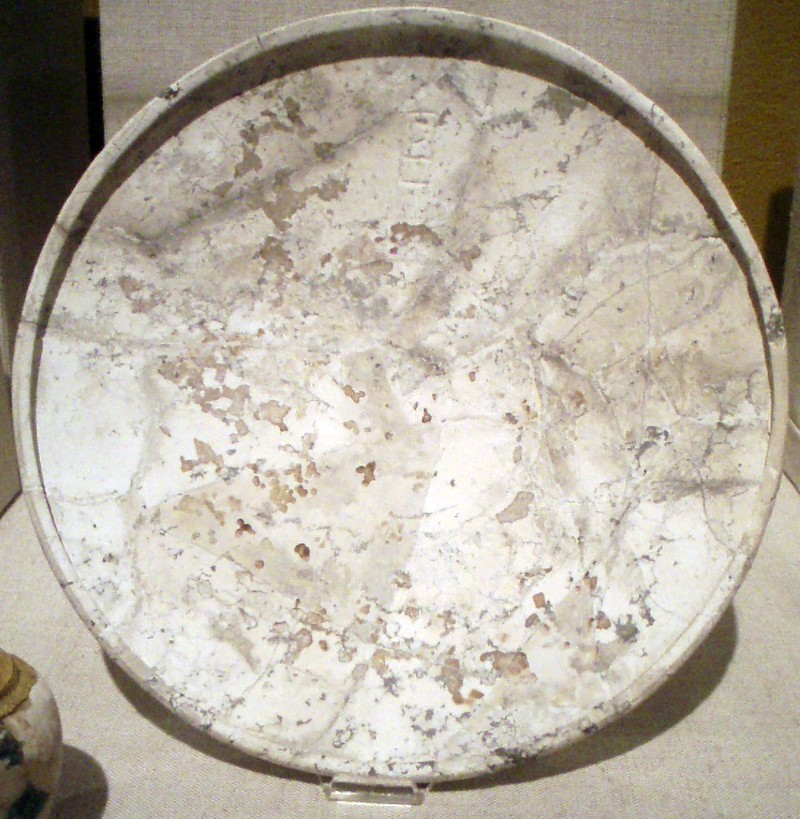
Dolomite bowl from the Museum of Fine Arts, Boston, engraved with the Horo name of Haba
The Layered Pyramid ("The Round Pyramid", sometimes called the "Layered Pyramid") is a stepped pyramid located a few miles from Saqqara towards Giza, in Zawiet el-Erian. Today it is almost completely destroyed.
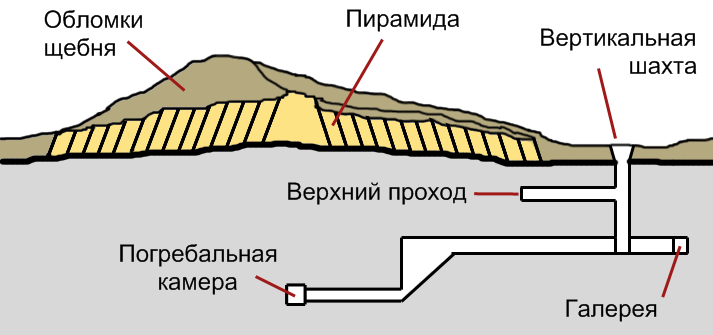
Its base is a pyramidal limestone hill with 14 rows or layers of masonry made of the same material. The pyramid covers an area of 10,000 m2 and is currently 17 m high. The burial room is carved into the rock under the pyramid. A staircase and a gallery leading to the north-east side lead to it. Outside the pyramid itself, from the northeast, north and northwest, a long corridor carved into the rocky ground with 32 cache-storerooms goes around it. Next to it there is an embankment and a deep well, apparently intended for another pyramid; however, it was never built.
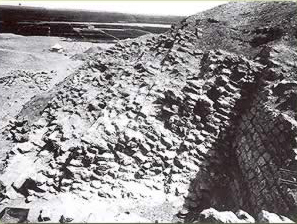
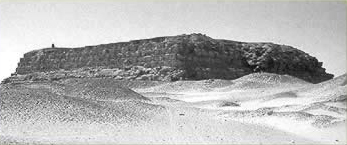
In the central part of the pyramid in Zawiet el-Erian, the structure of the masonry is clearly visible - the layers of stone are slightly inclined towards the center and, as it were, rest on it (because of this, it is sometimes also called "Layered"). The building material is a small rough hewn stone and clay mortar. The technology of building the pyramid in Zawiet el-Erian is similar to that used in the construction of the Sekhemkhet pyramid and the Step pyramid in Saqqara.
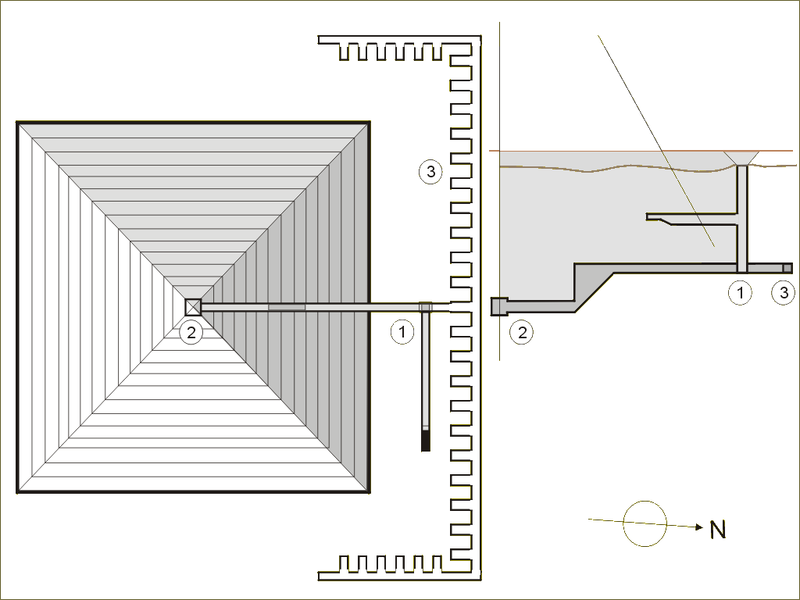
Inner corridors of the pyramid: 1) Stairs and descent to underground corridors 2) Corridor leading to the burial chamber 3) Complex of 32 corridors
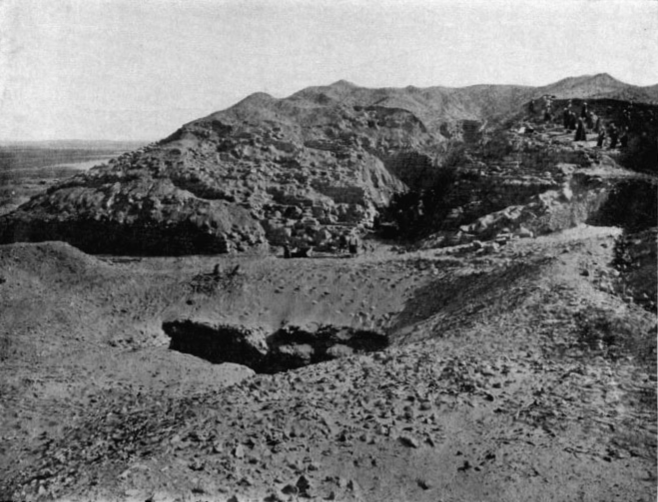
The first mention of this pyramid dates back to 1839, when it was discovered by John Shae Perring. A little later, K. Lepsius entered this pyramid into his list of pyramids under the number "14". In 1896 J. Morgan opened the entrance to the interior of the pyramid. In 1900 Alexandre Barsanti began to study this pyramid. It was also studied by George Andrew Reisner and Clarence Fisher.
Djoser's pyramid
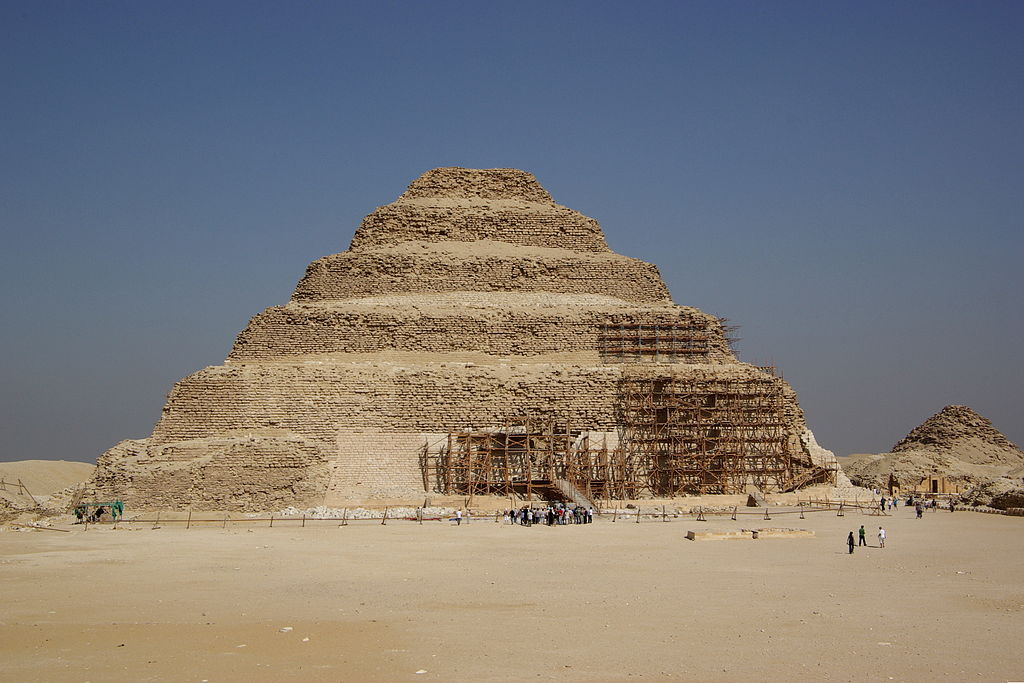
Step pyramid at Sakkara.
This is the first step-type pyramid, called the Djoser pyramid. The building dates back to around 2670 BC and looks like several stacked mastabas of decreasing size. Most likely, this was exactly the idea of the architect of this pyramid, Imhotep. Imhotep developed a method of masonry from hewn stone. Subsequently, the Egyptians deeply revered the architect of the first pyramid, and even deified him. He was considered the son of the god Ptah, the patron saint of arts and crafts.
The Pyramid of Djoser is located in Saqqara, northeast of ancient Memphis, 15 km from Giza. Its height is 62 m.
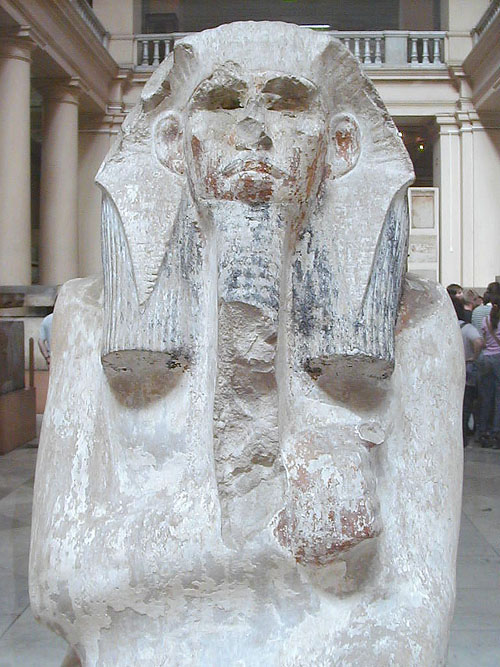
Statue of Djoser at the Cairo Museum
Djoser ("Sacred", Separating) Necherihet (Neherofes at Manetho; ruled ca. 2635-2611 BC) - the first pharaoh of the III dynasty and the era of the Old Kingdom in Egypt; considered the master of the first pyramid.
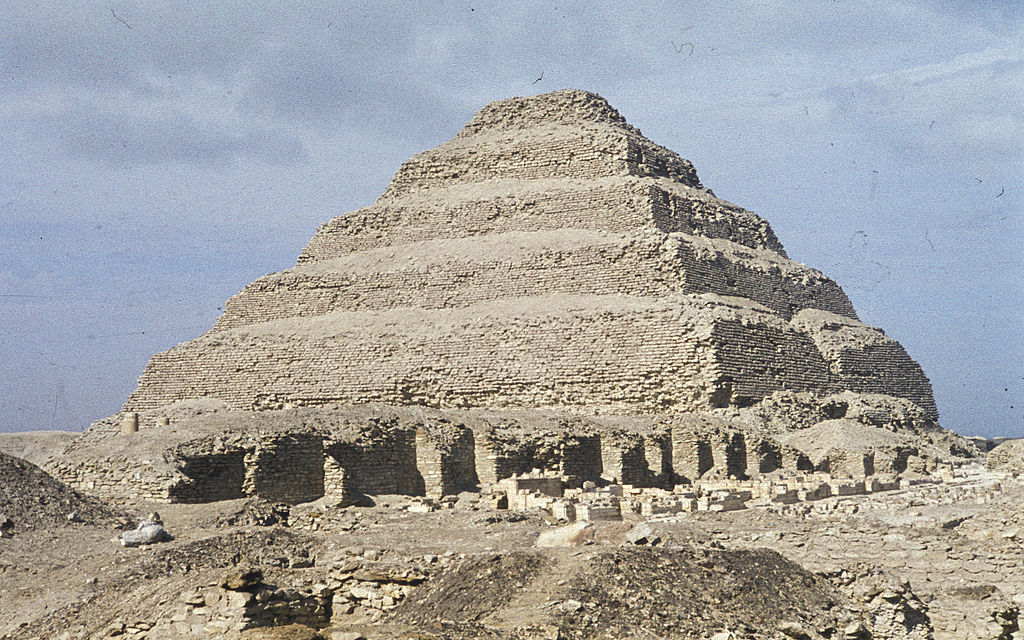
The son of the last Pharaoh of the II dynasty Hasekhemui and Queen Nimaathep. Under Djoser, the unification of Upper and Lower Egypt into a mighty despotism was completed. Memphis ("White Walls") finally became the capital of the state.
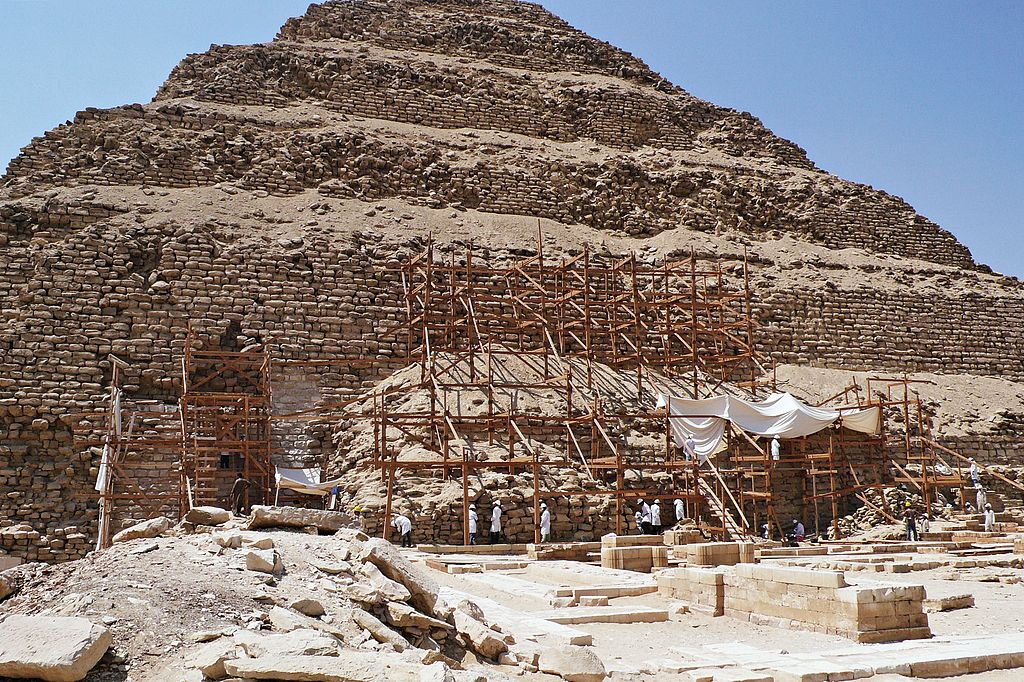
The name Djoser (more correctly Das) in translation from Egyptian means "Sacred". Unfortunately, even this name is a later version, which was not used for a long time after his death and was first encountered only during the XII dynasty. In contemporary inscriptions, Djoser is known under the "choral" name (one of the five official names of the pharaoh) - Khor-Necherihet. It was this name that was inscribed on the monuments built during the reign of Djoser.
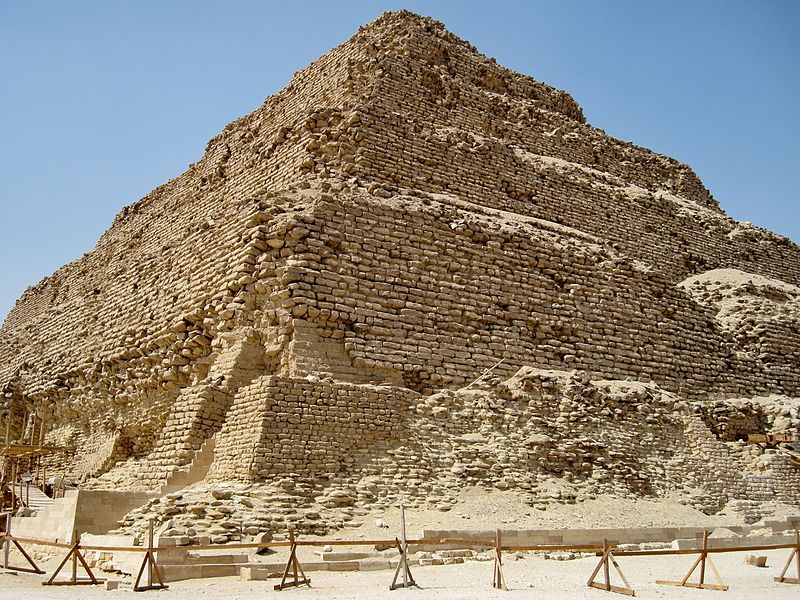
The name Necherihet consists of two words: "Necheri" - Divine and "Chet" (divine group) - Corporation, Union, Collegium. The highest point in the royal regalia and the names of the Choir of kings of the III dynasty are miniature theological treatises about the god Choir, the king and their relationship to each other and to a wider pantheon. In this position are the "echo" of the theological complex of the Pyramid Texts, some of which date from the early dynastic period. From Greek sources it is known as Tosorfros (at Manetho) or Sesorfos (at Eusebius of Caesarea).
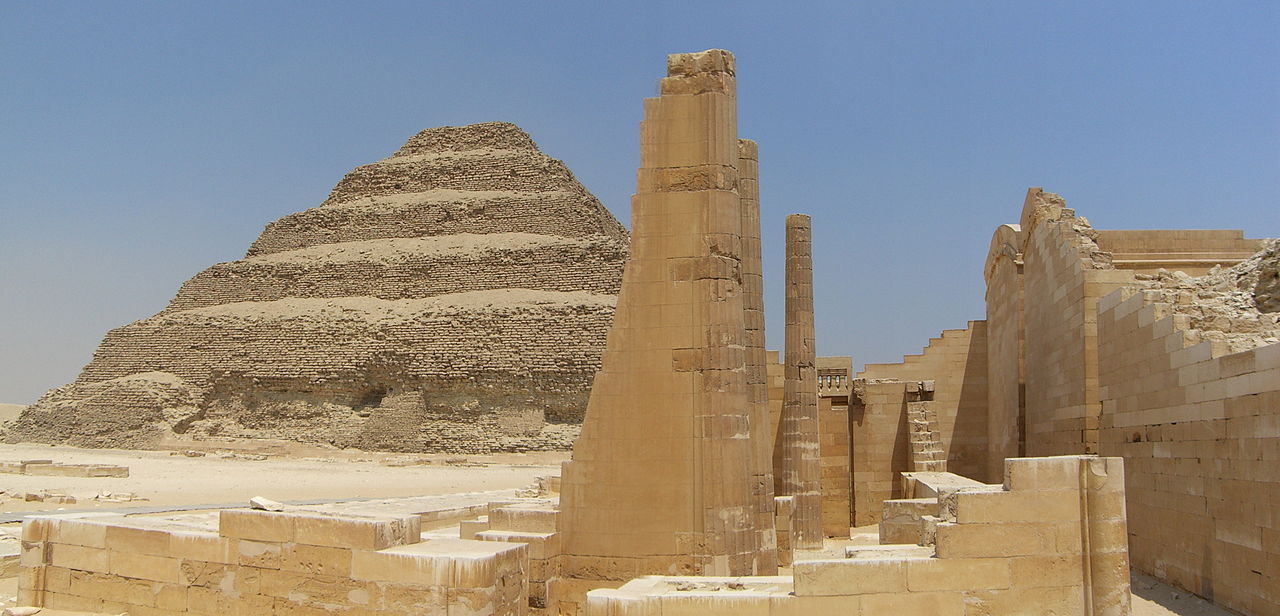
Djoser subjugated the Sinai Peninsula, rich in deposits of turquoise and copper, to the power of Egypt. Bas-reliefs in the Wadi Magkar region tell about the victory of Djoser over the nomads of the Sinai Peninsula and the consolidation of Egyptian rule over the turquoise and copper mines located here.
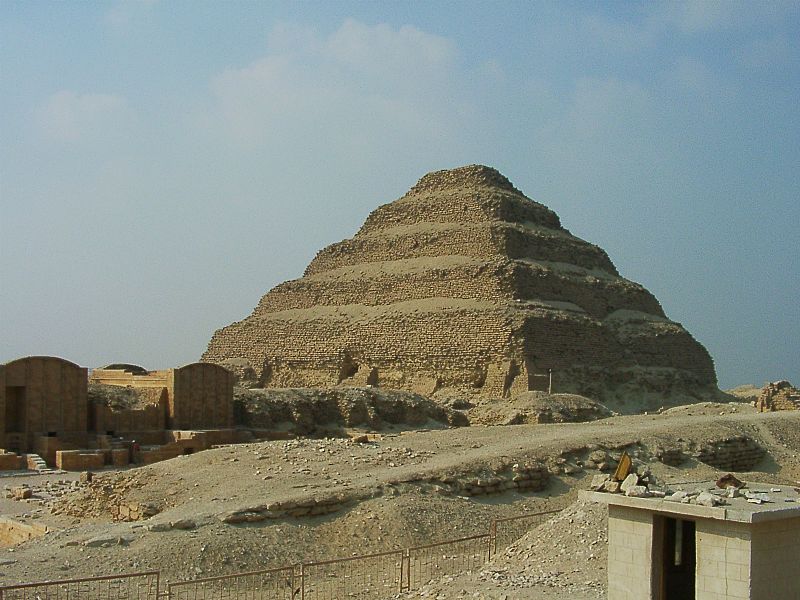
In the south, Djoser subdued part of Northern Nubia, reaching up to Takampso (about 125 km south of the first rapids of the Nile). To protect the southern regions of Egypt in the area of the first Nile threshold, a 12 km line of fortifications was created, which later became the official southern border Egypt.
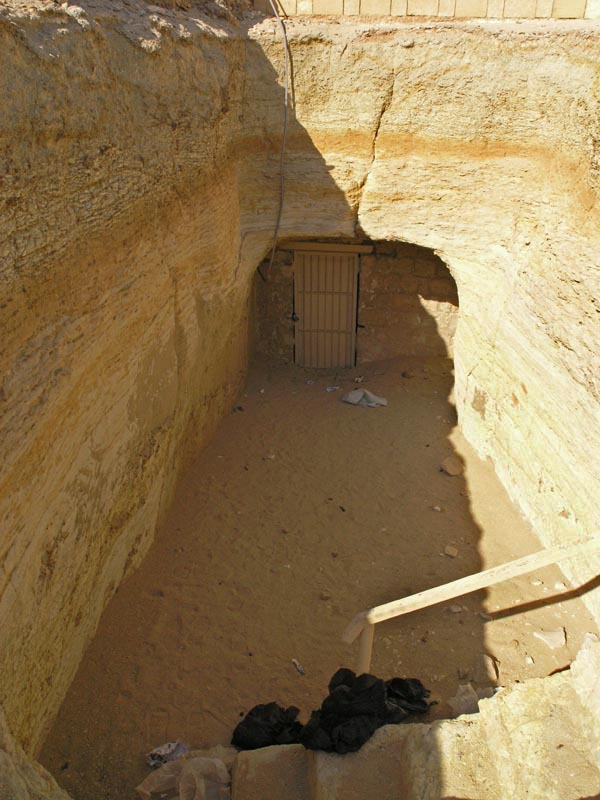
As a result campaigns of conquest the country received a large amount of labor, which was used in the construction, including the most remarkable creation of Djoser - the step pyramid and the complex of the funeral temple with it.
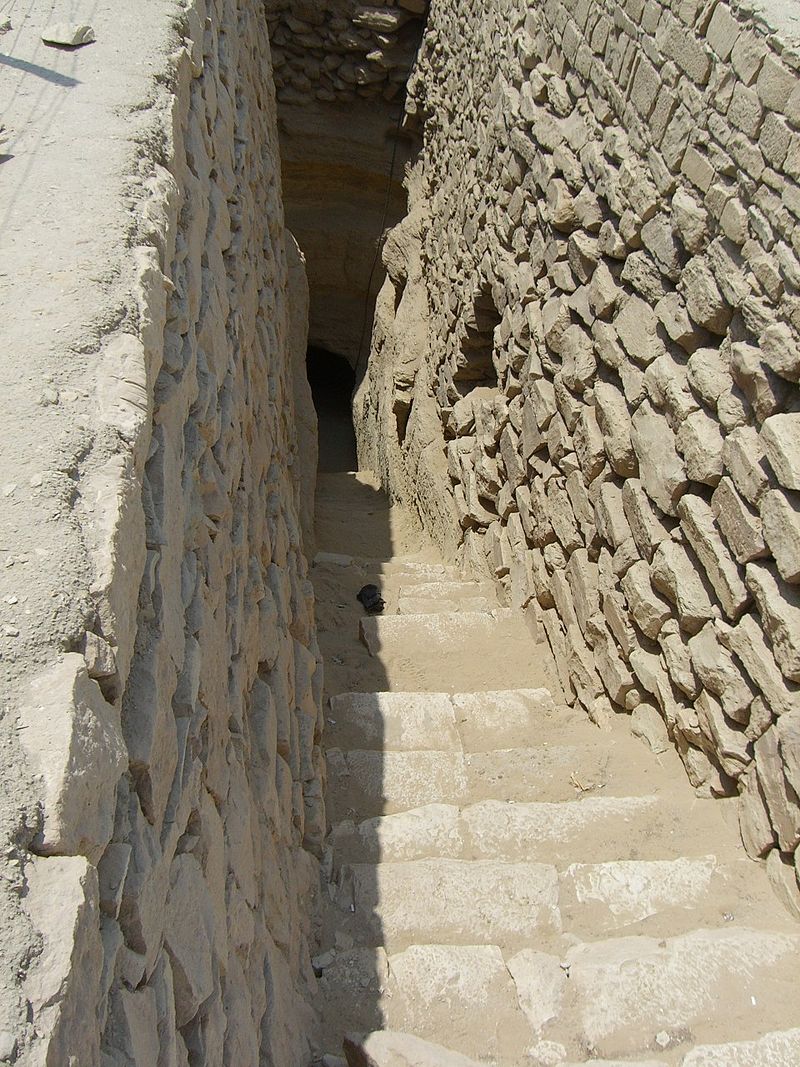
The construction of the Egyptian pyramids dates back to the reign of Djoser. His step pyramid (125 × 115 m and approximately 61 m high) at Saqqara was the first in ancient Egypt.

Until now, the pyramid of Djoser has been preserved in good condition, although its dimensions have slightly decreased and are 121 × 109 m, and the height is 59 m.The pyramid of Djoser is considered the world's first stone architectural structure. The styles and shapes found during the construction of this pyramid became a role model for the further development of stone construction not only in Ancient Egypt, but also in other civilized regions of the ancient world.
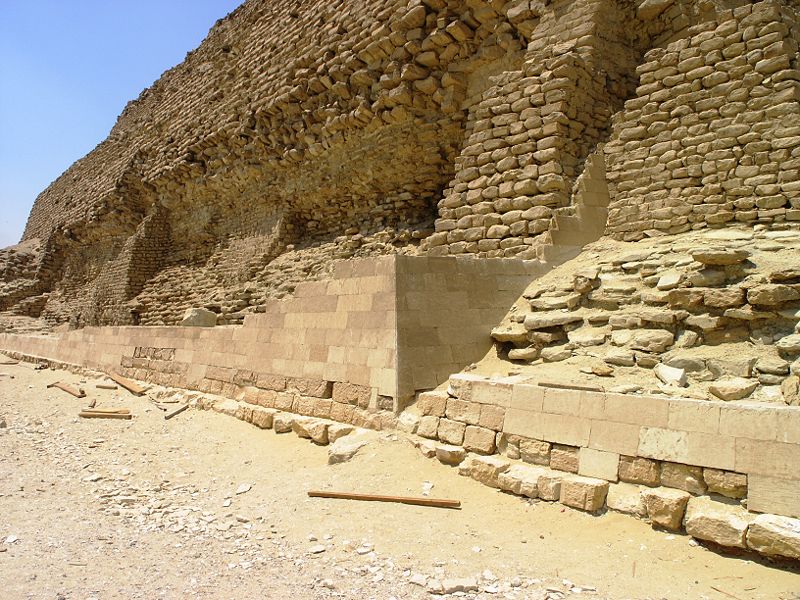
The architect of the pyramid of Djoser, according to the ancient Egyptian tradition, is considered the highest dignitary (chati) Djoser Imhotep. In the ancient Egyptian tradition, Imhotep was known as a wise man gifted with many talents - a teacher, doctor, astronomer and priest. His high position at the court of the king is described on the basis of the statue of Djoser, where the titles of Imhotep follow after the titles of the pharaoh: "keeper of the treasury of the king of Lower Egypt, the first after the king in Upper Egypt, manager of the great palace, chief priest of Heliopolis, Imhotep, builder, architect, sculptor of stone vases."
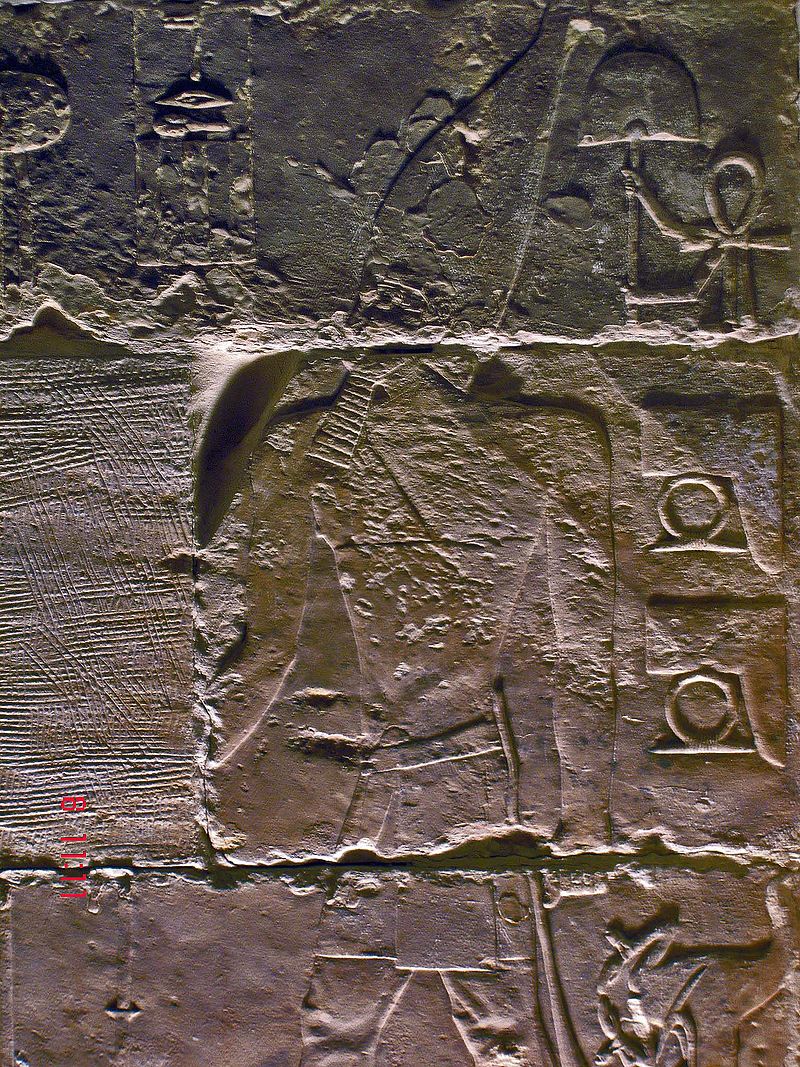
Later, Imhotep was deified, and in the Late and Classical period Imhotep was revered as the god of architecture and medicine, and the Greeks associated him with their god of medicine Asclepius. Pilgrims visited Sakkara, where Imhotep was probably supposed to be buried, whose tomb has never been found. In Sakkara, the burials of mummies of ibises have been preserved - a bird that was associated with both Imhotep and Thoth, the god of wisdom, writing and science. Ibis mummies were buried in the thousands in the animal necropolis northeast of the step pyramid complex.
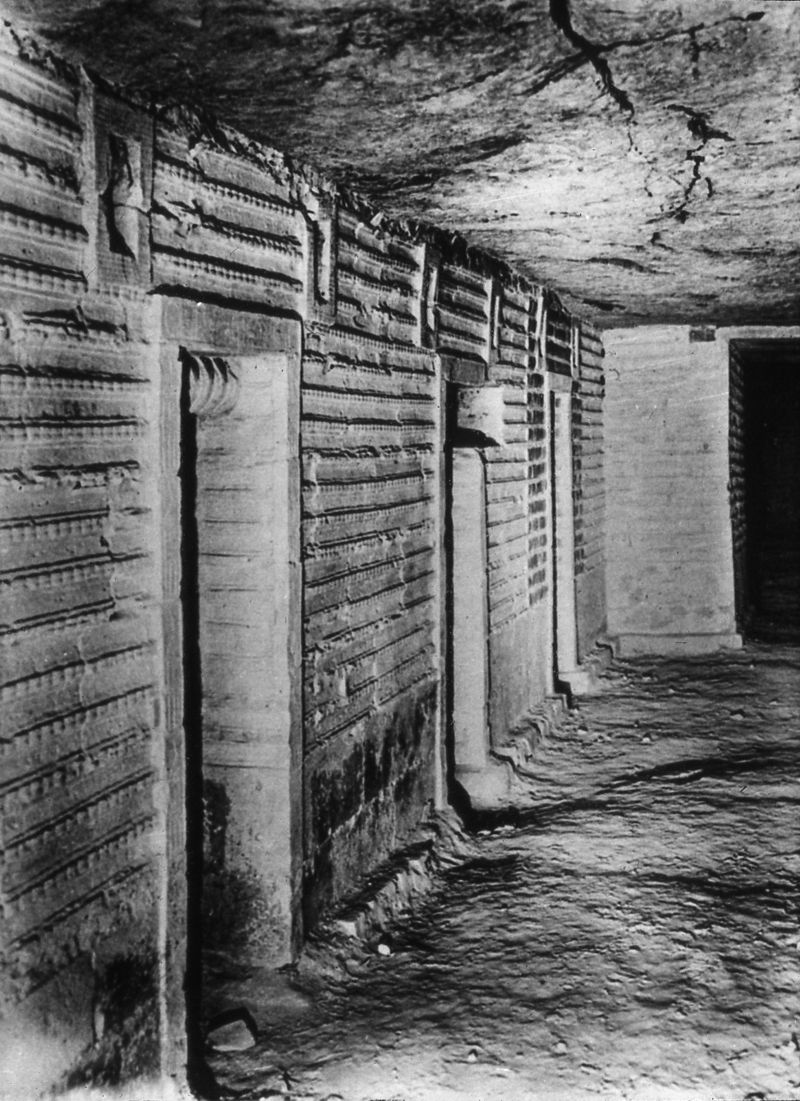
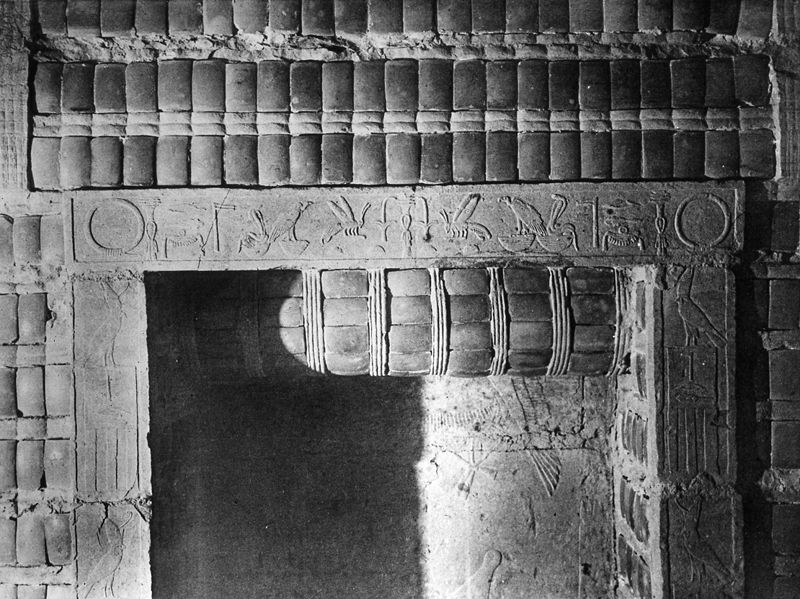

Initially, Imhotep planned to create an ordinary stone mastaba (rectangular tomb; in translation from Arabic - "bench"). Only in the process of construction did it turn into the first step pyramid. The construction took place in six stages, according to the number of steps. It is possible that the core of the tomb from limestone blocks was built for the brother of Djoser Sanakht.
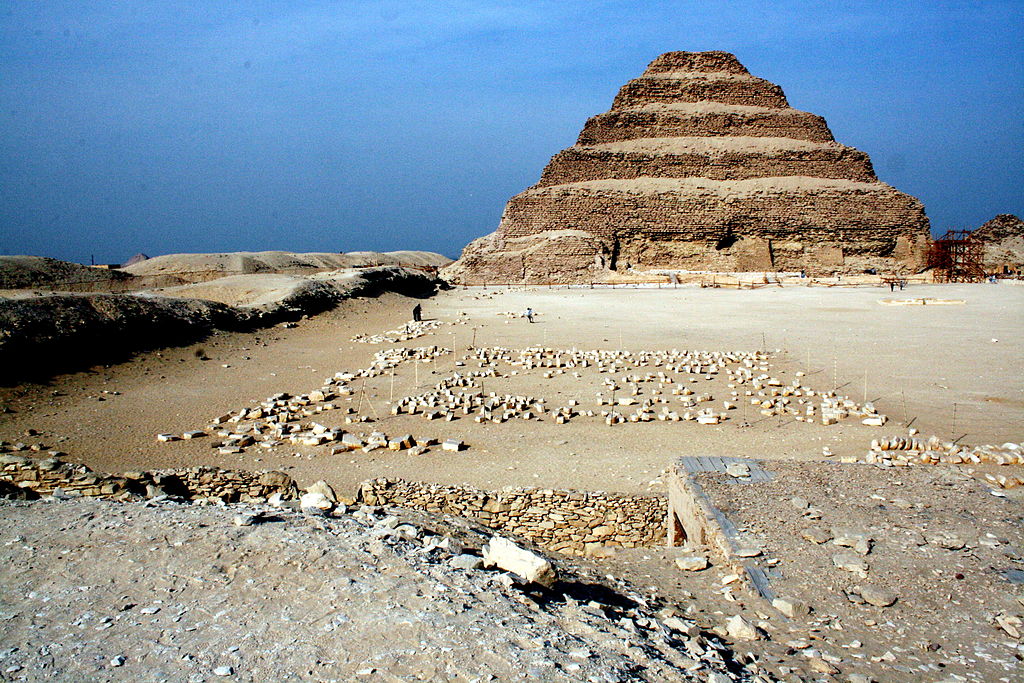
The pyramid of Djoser was intended for the entire family of the deceased, like the early mastabas. In the later pyramids, only one king was buried. In the Djoser pyramid, 11 burial chambers were prepared for family members in the tunnels of the pyramid. All his wives and children were buried there, including a mummy of a child of about eight years old. The body of Djoser himself was not found (probably only a mummified heel survived from him).
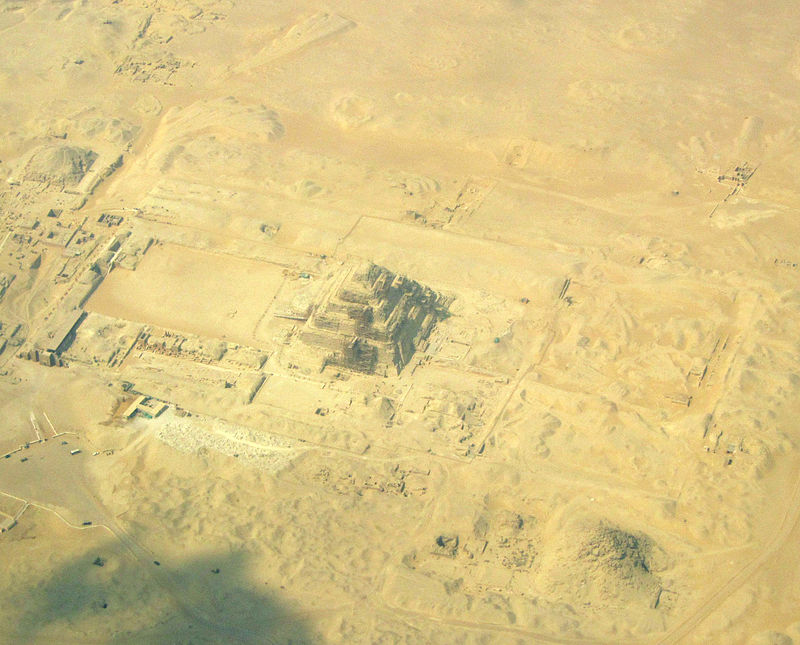
In addition to the pyramid at Saqqara, Djoser also ordered the construction of a symbolic tomb at Bet Hallaf, north of the necropolis in Abydos. The length of this brick mastaba was 100 m, and the height was 10 m. A long staircase led to a basement, divided by partitions into 18 rooms, among which there was a burial chamber made of limestone.
Sekhemkhet pyramid
The pyramid of Pharaoh Sehemkhet, also known as the buried pyramid, is an unfinished stepped pyramid. Built approx. 2645 BC e. near Saqqar, southwest of the pyramid of Djoser.
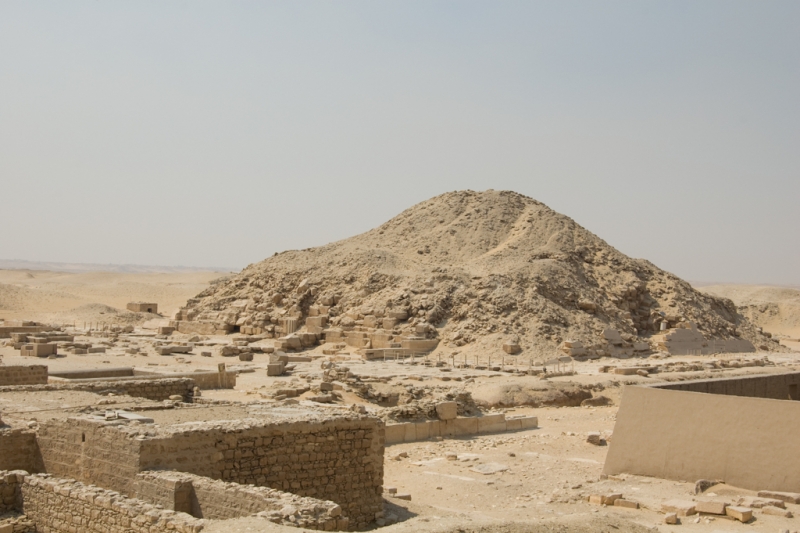
The dimensions of the unfinished wall were 550 x 200 meters. The height of the ruins is about 10 meters, but the dimensions of its square base are 120 meters each. Apparently, the pyramid was built according to a planned project. If the construction had been completed, the height of the monument would have been about 70 meters, which is 10 meters higher than that of the Step Pyramid.
Currently, only the ruins of the pyramid have survived, accessible to tourists, except for the underground rooms.
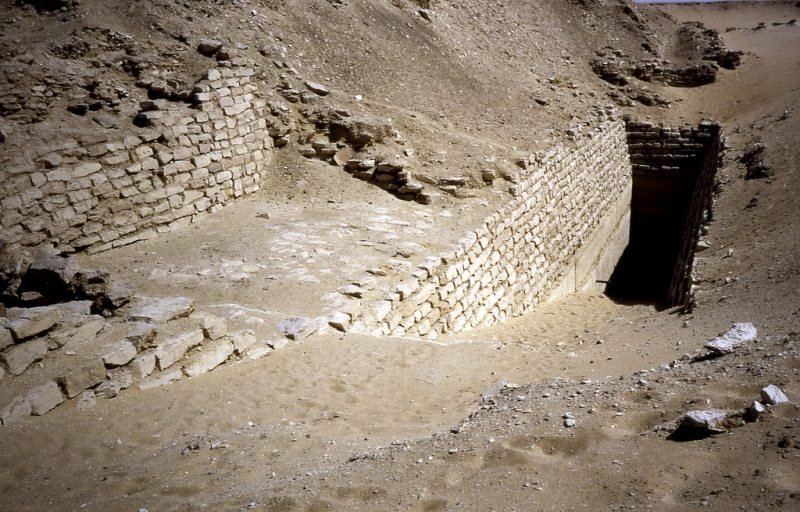
The pyramid of Sekhemkhet was unknown until 1951, when archaeologist Zakaria Goneim noticed a square shape in the desert during excavations. He unearthed a portion of the fence wall that looked like the Step Pyramid complex. The dimensions of the unfinished wall were 550 x 200 meters.

The name of the pharaoh who built the pyramid was unknown until some time. However, many Egyptologists were sure that this was one of the descendants of Djoser, since the structure was located close to his pyramid. In 1954, the building was discovered as an unfinished stepped pyramid. It consisted only of the lower and partly the second steps of the pyramid. The height of the ruins is about 10 meters, but the dimensions of its square base are 120 meters each. Apparently, the pyramid was built according to a planned project. If the construction had been completed, the height of the monument would have been about 70 meters, which is 10 meters higher than that of the Step Pyramid.

During excavations, Goneim found a number of objects: animal bones, papyri and stone vessels from the 3rd dynasty of Ancient Egypt. In one of the wooden boxes decorated with gold, gold bracelets and beads were found.

On May 31, 1954, they managed to penetrate one of the closed walls, where the burial chamber was discovered. Inside the room was an alabaster sarcophagus, carved from a single block with a vertical lid. However, on June 26, 1954, after great difficulties in unlocking and lifting the lid, the sarcophagus was opened and, to the disappointment of everyone, turned out to be empty.
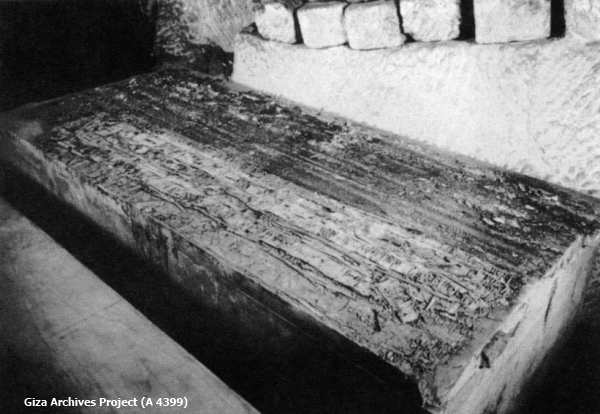
After Goneim's suicide on January 12, 1959, exploration of the ruins was suspended. In 1963, excavations were resumed again by Jean-Philippe Lauer.
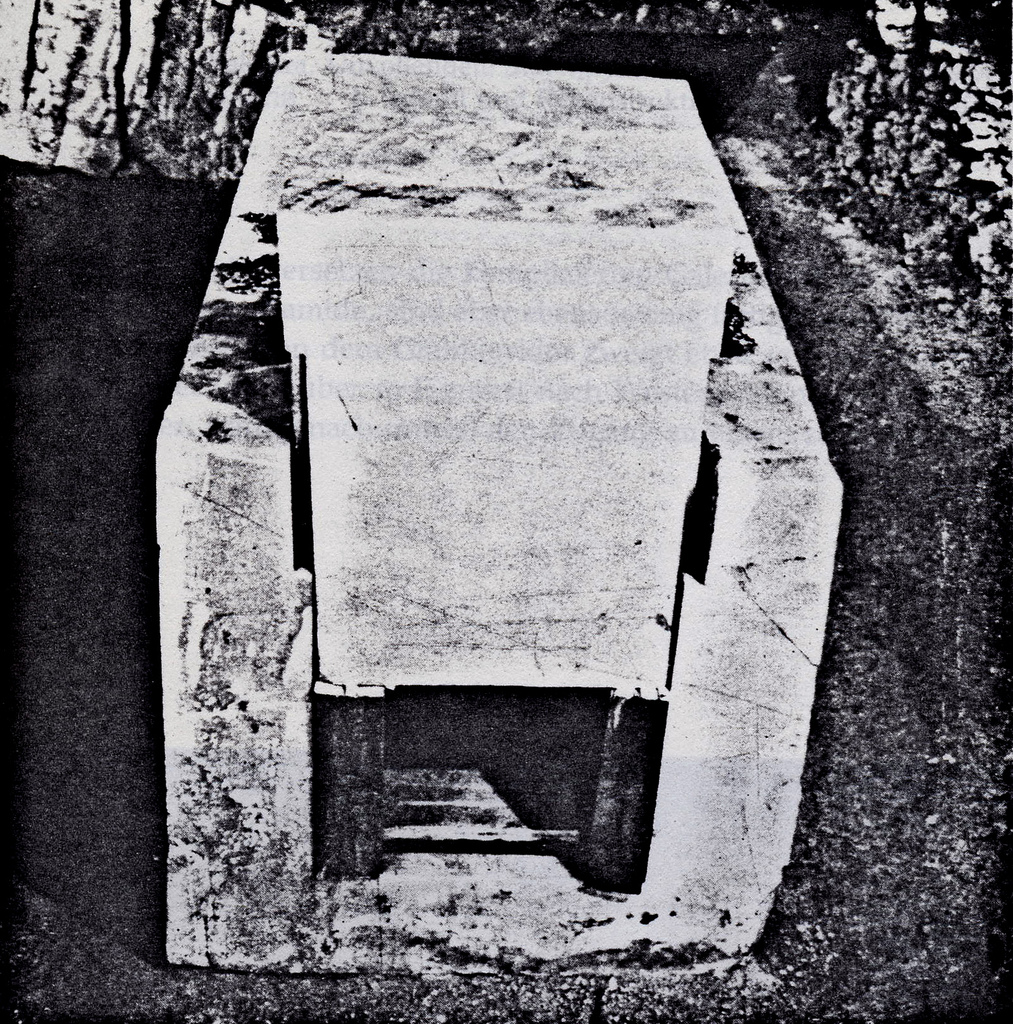
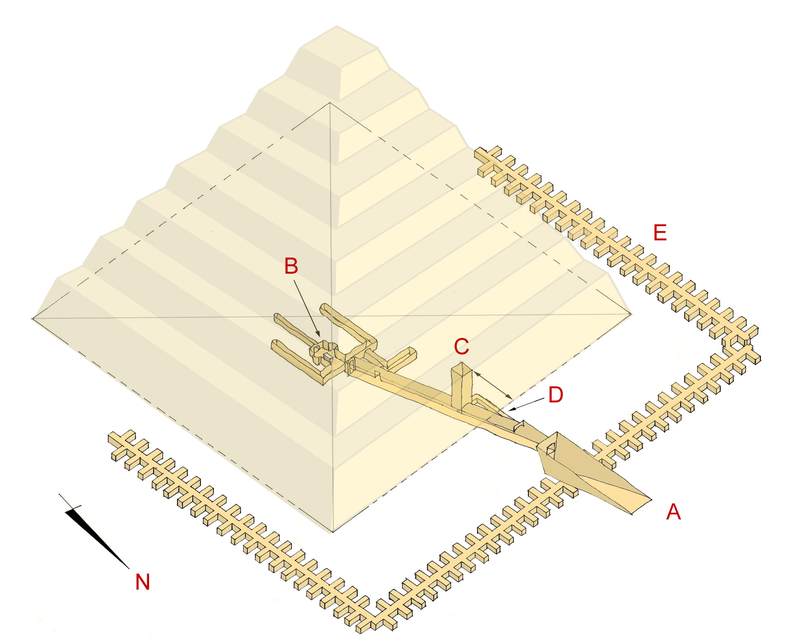
Schematic representation of the pyramid complex
The Sekhemkhet pyramid complex was built southwest of the Djoser pyramid in Sakkara and includes a pyramid, an underground structure, and a necropolis.

On one of the walls surrounding the pyramid, the name of Imhotep was discovered, which makes it possible for him to participate in the construction of the pyramid.
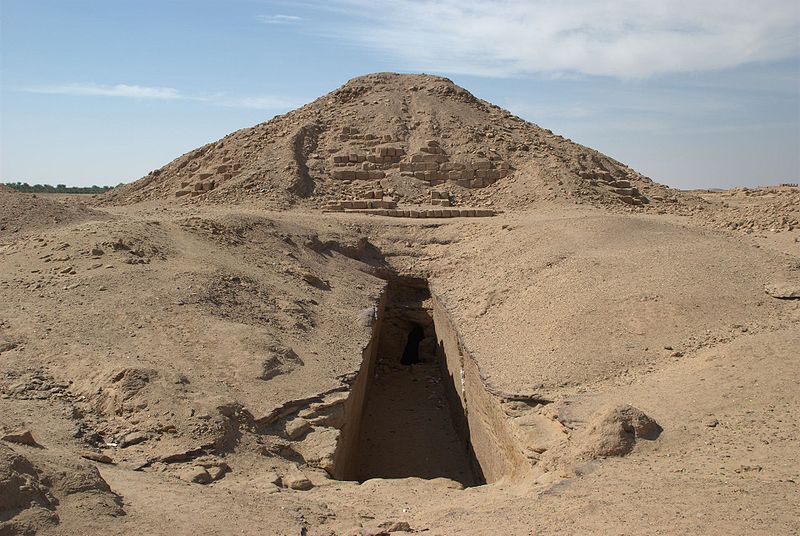
The location of the necropolis is aligned from north to south, but with an accuracy deviation of about 11 °. Characteristic feature this part of the monument is the inner limestone wall covered with red drawings.
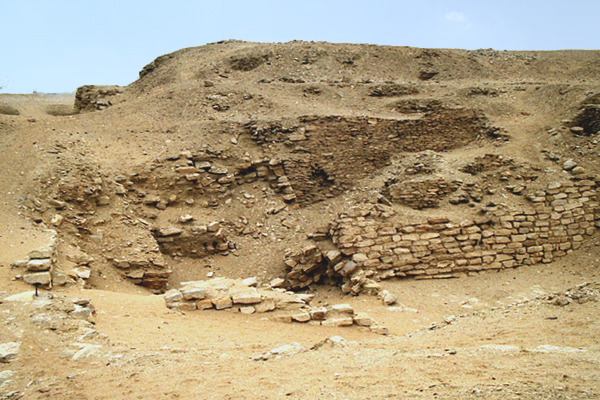
It is not known how many burial chambers and rooms should have been located in the dungeons according to the original plan. In 1963, a southern tomb with dimensions of 32 × 16 meters was found - behind a walled up wall there was a wooden coffin, inside which were the remains of an unidentified two-year-old child. It is quite clear that the child cannot be Pharaoh Sehemkhet, since he is represented as an adult in the drawings from the Wadi Magar mine in Sinai.
To be continued...
Dodson A., Hilton D. The Complete Royal Families of Ancient Egypt.
SWELIM, Nabil, The Dry Moat of the Netjerykhet Complex, in: Pyramid Studies. Essays Edwards, 12-22. (plans, pl.).
Zakaria Goneim: Die verschollene Pyramide. 1955; Neuauflage: Books on Demand, Norderstedt 2006.
Jean-Philippe Lauer: Die Königsgräber von Memphis. Grabungen in Sakkara. Lübbe, Bergisch Gladbach 1988,
Miroslav Verner: Die Pyramiden. Rowohlt, Hamburg 1998, ISBN 3-499-60890-1, S. 165-174 Die Stufenpyramide des Sechemchet.
Mark Lehner: Geheimnis der Pyramiden. Econ, Düsseldorf 1997, ISBN 3-572-01039-X, S. 94-94.
Rainer Stadelmann: Die ägyptischen Pyramiden. Vom Ziegelbau zum Weltwunder. 3. Auflage, von Zabern, Mainz 1997




